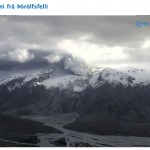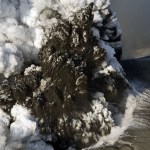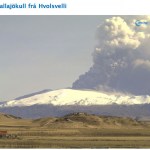Grading grading grading!
A webcam capture of the eruptive plume from Eyjafjallajökull on the morning of May 6, 2010.
News:
A quick update on the Eyjafjallajökull eruption: The volcano has been producing an impressive ash plume over the last day (see image above). The current ash plume is reaching 5.8-6 km height (19-20,000 ft) - and causing some trouble over Ireland and Scotland. However, much of airspace closed yesterday has reopened (for now). You can see two new images of the ash plume over at the NASA Earth Observatory. As for the continued fallout from the ash plume from April,…

A shot of the strombolian activity at the vent of Eyjafjallajökull, taken on May 4, 2010. Image courtesy of the Iceland Met Office.
The latest news from the Eyjafjallajökull eruption has the volcano erupting more explosively again (see above), possibly due to an increased influx of water into the vent area - in any case, the ash has become denser (by volume in the air) and the plume is higher (see below) than in the last couple of weeks. The rate of lava flow extrusion has also gone down in the last few days. The latest update from the Iceland Met Office has a lot of details on the current…
The steam plume from a lava flow moving down the slopes of Eyjafjallajökull on May 2, 2010.
A quick note on the activity at Eyjafjallajökull in Iceland: The ash from the ongoing eruption has caused a partial closure of airspace over Ireland from 0600 to 1200 on Tuesday May 4. This is one of the first closures of European airspace since airspace reopened over 10 days ago. This closure is based on the predicted location of ash in flight corridors over Ireland tomorrow.
The Icelandic Met Office has released two interesting updates on the activity at Eyjafjallajökull. The first describes the…
Mt. Saint Helens erupting in 2004.
I had a chance to watch a new NOVA special that airs May 5 (PBS) on the 1980-1986 and 2004-2008 eruption cycles at Mt. Saint Helens, along with the recovery of the blast zone from the 1980 eruption. It is a fitting episode as we approach the 30th anniversary of the eruption that took out the north side of the volcano and devastated a vast swath of Cascade wilderness in Washington on May 18, 1980. Many of you have already sent me your Mt. Saint Helens memories (keep them coming!) for my tribute to the eruption, but if you want to get started on remembering…
Webcam capture of Eyjafjallajökull erupting on May 2, 2010. You can see the steam plume on the middle flanks of the volcano - this is likely a lava flow coming from the summit vents.
A brief update on activity at Eyjafjallajökull:
Overnight, the lava flows from Eyjafjallajökull could be seen in the crater of the ice cap - some of the images posted by Eruptions readers are simply stunning. You can clearly see the red glow of the strombolian eruptions at the vent, and the glow of the lava flows as they had down the slope of the volcano. This has brought a lot of new melting to the snow/…
Chaiten in Chile erupting on May 5, 2008, four days after the volcano came back to life after ~9,000 years of dormancy.
Quick post ... but until I was reminded by Eruptions reader Guillermo, I had forgotten two important anniversaries.
First, today (May 1) marks the 2nd anniversary of the start of the Chaiten eruption in Chile. The eruption is still rumbling along (spanish), with growth of three domes in the Chaiten caldera. I'll have more to say about this on Monday.
Secondly, today also marks the second anniversary for the start of this blog! Yes, if you can believe it, Eruptions turns two…
Mt. Saint Helens erupting in 1980.
As many of you might (or might not) now, we're heading towards the 30th anniversary of the dramatic eruption of Mt. Saint Helens in Washington state. Now, I could fill a book with the information out there on the volcano and the eruption, but instead, I think it would be more interesting to get your takes on the eruption. I have to admit, I was all of three when the eruption occurred, so my memories of the event are hazy at best, but if you have any memories, reactions or thoughts you want to share on the events leading up to the eruption, the eruption…
News!
Colima in Mexico erupting in 2008.
The current activity at Eyjafjallajökull is more-or-less unchanged, with strombolian activity producing a 3-4 km tall ash-and-steam plume and the lava flows at the crater moving northward towards the GÃgjökull glacier. You can check out an extensive page on the state of this eruption at the Nordic Volcanological Center - along with a new page with thermal and LIDAR information on the eruption from France.
The Icelandic Met Office notes that the lava has been producing meltwater from the glacier - which many Eruptions readers have noticed as floods…
An undated painting of the island volcano of Ischia near the Bay of Naples, Italy.
Guess what? It is the end of the semester (well, school year) here at Denison, so I might be a little busy for the next couple weeks.
Here are some news bits (with special thanks to all who emailed me some of these links):
Boris might have more information or opinion on this, but Italy is back in the news concerning the threat of volcanism to the country. This time the volcano is Ischia, off the coast in the Bay of Naples. Guido Bertolaso of Italy's civil protection agency is quoted as saying that the "magma…
Guatemala's Santa Maria volcano with the dome complex visible in the foreground.
I got a tip the other day from an Eruptions reader of something afoot at Guatemala's Santiaguito - a part of the larger Santa Maria volcano - and sure enough, there are reports today that the volcano is experiencing an "unusual and violent" display. The articles I can find only mention that ash was spread over six provinces in the western part of the country, which is unusual for this volcano that normally produces diffuse ash plumes and minor dome collapse avalanches (at least in the recent past). The Institute…
Night image of Eyjafjallajökull erupting on April 24, 2010. Image courtesy of James Ashworth.
A quick update on the Eyjafjallajökull eruption: Not a lot to report in terms of changes in the volcanic activity at the volcano. The update from the Icelandic Met Office last night sums it up nicely:
Overall activity similar as yesterday. Eruption seen from west in the morning - north crater still active. External water has not affected vent activity much since 18 April. Geologists' field observations (2-10 km from vents) show that explosivity is magmatic and that the tephra produced since 18…
I just wanted to leave a quick note - I've been getting quite a bit of email, as you might imagine, so I've gotten a little behind in responding. So, please don't take it personally if you haven't heard back from me. I'll try to get through the backlog, but with the increased volume combined with the end of the semester here, it might take a bit.
On a related note, I might try to figure out how I can embed a chat into the blog periodically for live chats about volcanoes ... we'll see if I can figure out how to do that.
That being said, keep the emails and questions coming!
A night shot of the Eyjafjallajökull eruption showing the glowing plume from the strombolian explosions and the Aurora Borealis overhead.
A quick update on the current activity at Eyjafjallajökull eruption: the eruption continues at the summit craters, but there seems to be less ash being erupted, at least yesterday. The latest update from the Icelandic Met Office suggest that things are settling down - but floods are still periodically being produced by melting of the glacier:
Volcanic tremor has been similar the last 24 hours. GPS stations around Eyjafjallajökull showed deflation…
A strombolian eruption in the crater of Eyjafjallajökull, taken on April 19, 2010. Image courtesy of the Icelandic Met Office.
The Eyjafjallajökull eruption in Iceland has been one of the most fascinating eruptions in recent memory - and this is beyond the fact that it is a prime example of a "wired" eruption, where people from around the world can follow every aspect of the eruption from the comfort of their home. What will really be interesting is the political fallout from the six day closure of the airspace over most of Europe due to the ash. If you read the press, you'd think that…
The ash-and-steam plume from Eyjafjallajökull on April 19, 2010.
Eyjafjallajökull in Iceland is slowly settling into a pattern of strombolian-to-surtseyan (depending on meltwater access to the crater) explosions that have been sending ash up to 2-5 km above the summit. We can see this new, more diffuse plume in the recent NASA EO image of the eruption taken April 19. There is still abundant ice to melt at the summit as there have been a number of floods overnight and this morning near the volcano, betraying the continuing production of meltwater by the eruption. The Icelandic Met office…
Gaua erupting in February 2010. Image courtesy of the NASA Earth Observatory.
As a certain famous Icelandic native would say, "there is more to life than this."
Some other volcano news from around the world:
The situation at Gaua in Vanuatu is worsening. Ash from the current eruption is contaminating water and food supplies on the island. Authorities are planning on evacuating 3,000 people from the island if the eruption that started in 2009 gets worse, but there has already been significant ash fall, mudflows and explosions.
Shiveluch on the Kamchatka Peninsula in eastern Russia continues…
Eyjafjallajokull erupting on 4/17/2010, image by Marco Fulle. Note the "rooster tails" of ash and steam, typical for Surtseyan eruptions.
European airspace has slowly begun to reopen as the explosive eruptions at Eyjafjallajökull have become less intense over the last 24 hours. However, there is still lots of hazardous airspace and airports around places like London and across the UK remain closed - leaving people stranded. We will still have to wait to see what the political ramification are, especially after EU officials claim "flaws" in their decision and the over $1 billion losses by…
National Geographic film crew near Eyjafjallajökull, April 18, 2010.
UPDATE 1PM EDT 4/19/2010: I can almost categorically say that Hekla is NOT erupting, contrary to Twitter or the brief banner on MSNBC. See my comment below (#68).
In what is sounding like a bit of a broken record, the eruption at Eyjafjallajökull is still going. However, we might be beginning to see some changes in the style of volcanism - even the first suggestion of lava flows at the new crater. As mentioned yesterday, since the eruption became subglacial, we've been seeing eruptions where water - in this case glacial…
Some very quick notes on Eyjafjallajökull:
Eyjafjallajökull erupting at night on April 17/18, 2010, with impressive incandescent explosions.
European airlines are taking "test flights" to see the effect of the ash on their aircraft in hopes to convince EU officials to reopen airspace. Now, officials from KLM say that everything went fine in their test flight, but I haven't seen any details about flightplans, altitude and all the sorts of info you'd want to see if you want to believe these test flights are representative. However, the president of KLM does have a bit of a point in saying…
Webcam shot of Eyjafjallajökull erupting on April 17, 2010.
I don't want to get too far into this but there has been a lot of chatter about the link between melting ice caps and increase/decrease/neither of volcanism. The two main articles we're talking about are:
Scientific American, saying that ice loss could increase volcanism:
Ice cap thaw may awaken Icelandic volcanoes
The long and short of the Scientific American study is that you reduce the pressure of rocks in the crust/mantle below Iceland, you generate more melting - depressurization melting of rock. If you melt the ice cap, you…



